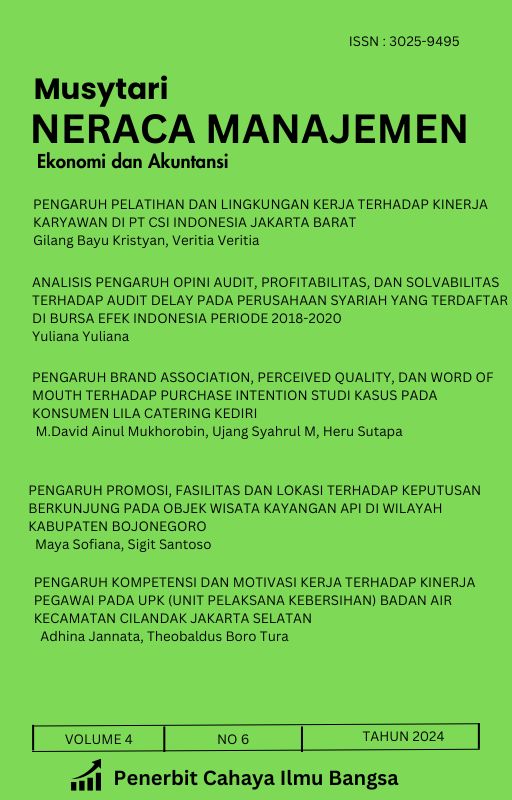STRATEGI, INOVASI, DAN KEUNGGULAN KOMPETITIF: STUDI LITERATUR TERKAIT UPAYA UNTUK MENINGKATKAN KINERJA BISNIS
Main Article Content
Abstract
Penelitian ini bertujuan untuk mengeksplorasi hubungan antara strategi, inovasi, dan keunggulan kompetitif dalam membangun daya saing perusahaan. Dengan menggunakan pendekatan literature review, penelitian ini mengidentifikasi bagaimana integrasi antara strategi yang efektif dan inovasi yang berkelanjutan dapat menciptakan keunggulan kompetitif yang relevan serta sulit ditiru. Strategi berfungsi sebagai pedoman bagi perusahaan untuk mengelola sumber daya dan kapabilitas mereka, sedangkan inovasi menjadi pendorong utama dalam menciptakan nilai unik di pasar. Hasil penelitian menunjukkan bahwa perusahaan yang mampu mengadopsi kapabilitas dinamis untuk merespons perubahan pasar memiliki peluang lebih besar untuk mempertahankan keunggulan kompetitif. Penelitian ini memberikan wawasan teoritis dan praktis bagi perusahaan untuk mengembangkan pendekatan strategis yang lebih adaptif serta inovatif di tengah persaingan global.
This research is designed to examine how strategy interacts with innovation in realizing competitive advantage-the competitive core of corporate competitiveness. Using a literature review as the primary approach, the current research identifies how effective strategy coupled with sustainable innovations creates relevant, and hard-to-copy competitive advantages. Strategy in a company is a primary marker for the organization to manage its resources and capabilities. Innovation is primarily the catalyst against which unique market values are created. The results show that the development of dynamic capabilities in a firm translates into economizing in responding to market changes and hence deriving a larger probability of sustaining competitive advantage. This leads to theoretical and practical contributions concerning adaptive and innovative strategic approaches for economic agents competing globally.
Downloads
Article Details

This work is licensed under a Creative Commons Attribution-NonCommercial 4.0 International License.
This work is licensed under a Creative Commons Attribution-ShareAlike 4.0 International License.
References
Ali, M. (2021). Imitation or innovation: To what extent do exploitative learning and exploratory learning foster imitation strategy and innovation strategy for sustained competitive advantage? Technological Forecasting and Social Change, 165, 120527.
Annarelli, A., Battistella, C., & Nonino, F. (2020). Competitive advantage implication of different Product Service System business models: Consequences of ‘not-replicable’capabilities. Journal of Cleaner Production, 247, 119121.
Assensoh-Kodua, A. (2019). The resource-based view: A tool of key competency for competitive advantage. Problems and Perspectives in Management, 17(3), 143.
Cillo, V., Petruzzelli, A. M., Ardito, L., & del Giudice, M. (2019). Understanding sustainable innovation: A systematic literature review. Corporate Social Responsibility and Environmental Management, 26(5), 1012–1025.
Cooper, R. G. (2019). The drivers of success in new-product development. Industrial Marketing Management, 76, 36–47.
Donkoh, S., & Mensah, J. (2023). Application of triangulation in qualitative research. Journal of Applied Biotechnology and Bioengineering, 10(1), 6–9.
Fainshmidt, S., Wenger, L., Pezeshkan, A., & Mallon, M. R. (2019). When do dynamic capabilities lead to competitive advantage? The importance of strategic fit. Journal of Management Studies, 56(4), 758–787.
Frohlich, C., & Bitencourt, C. C. (2019). Dynamic capabilities for the development of innovation capability. Revista de Administração Da Universidade Federal de Santa Maria, 12(2), 286–301.
Fuchs, C., & Golenhofen, F. (2019). Mastering disruption and innovation in product management. Springer International Publishing.
Haarhaus, T., & Liening, A. (2020). Building dynamic capabilities to cope with environmental uncertainty: The role of strategic foresight. Technological Forecasting and Social Change, 155, 120033.
Islami, X., Mustafa, N., & Latkovikj, M. T. (2020). Linking Porter’s generic strategies to firm performance. Future Business Journal, 6, 1–15.
Johnson, P. C., Laurell, C., Ots, M., & Sandstrom, C. (2022). Digital innovation and the effects of artificial intelligence on firms’ research and development–Automation or augmentation, exploration or exploitation? Technological Forecasting and Social Change, 179, 121636.
Kaur, V. (2019). Knowledge-based dynamic capabilities. Springer International Publishing.
Kotter, J. P., Akhtar, V., & Gupta, G. (2021). Change: How organizations achieve hard-to-imagine results in uncertain and volatile times. John Wiley & Sons.
Mahto, R. V., Belousova, O., & Ahluwalia, S. (2020). Abundance–A new window on how disruptive innovation occurs. Technological Forecasting and Social Change, 155, 119064.
Paley, N. (2021). The manager’s guide to competitive marketing strategies. Routledge.
Rane, N. L., Achari, A., & Choudhary, S. P. (2023). Enhancing customer loyalty through quality of service: Effective strategies to improve customer satisfaction, experience, relationship, and engagement. International Research Journal of Modernization in Engineering Technology and Science, 5(5), 427–452.
Siahaan, M. (2023). Analysis and evaluation of the business innovation strategy: A case study of Apple Inc. Enigma in Economics, 1(2), 42–48.
van Dinter, R., Tekinerdogan, B., & Catal, C. (2021). Automation of systematic literature reviews: A systematic literature review. Information and Software Technology, 136, 106589.

